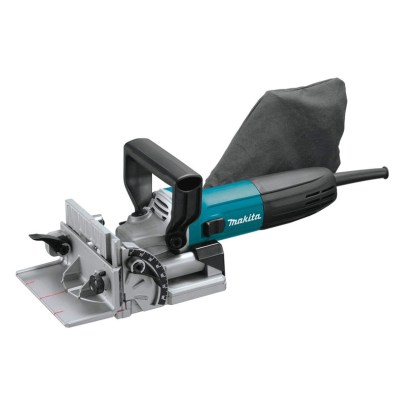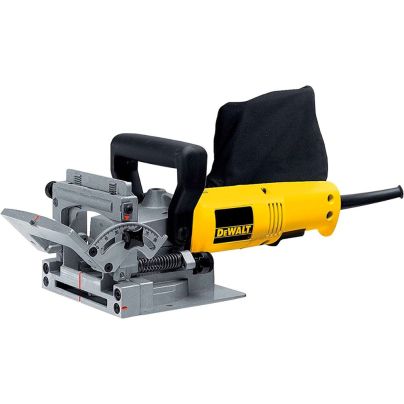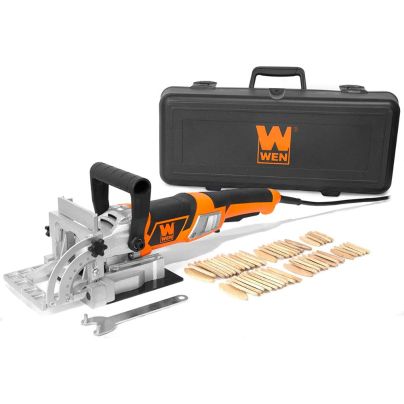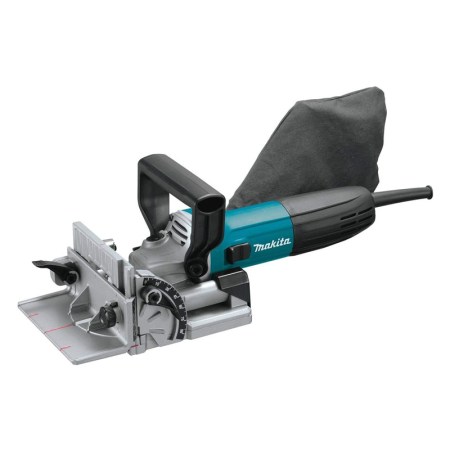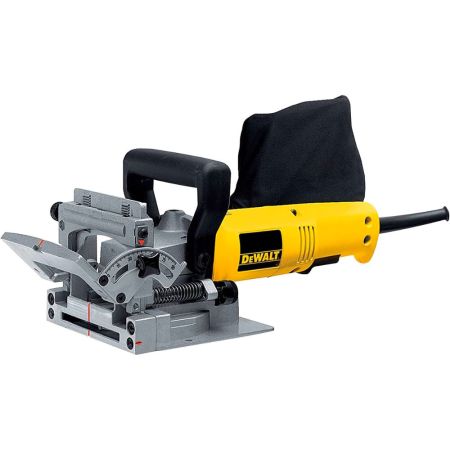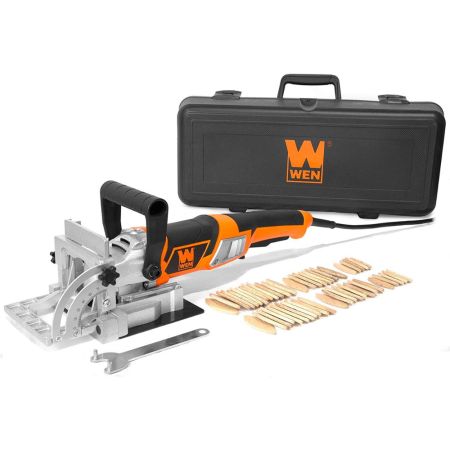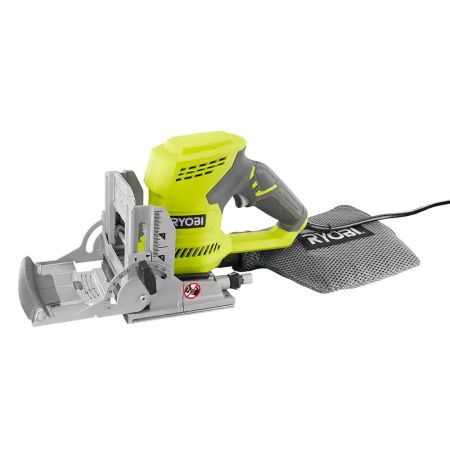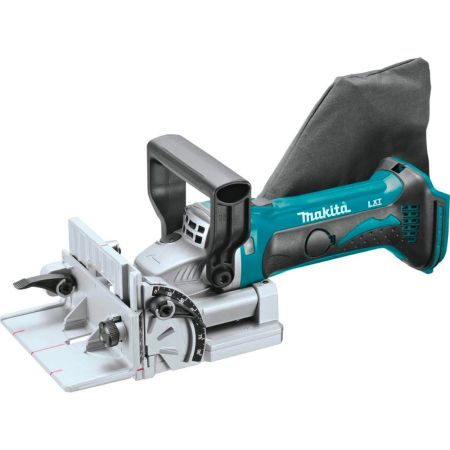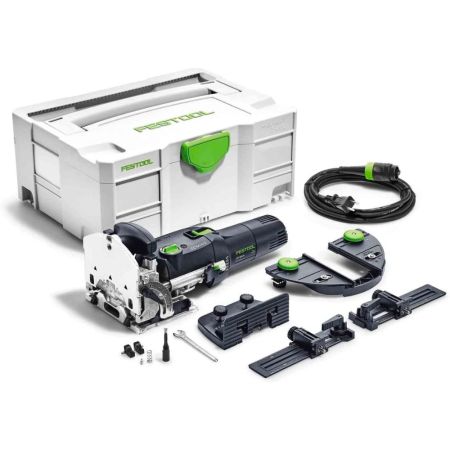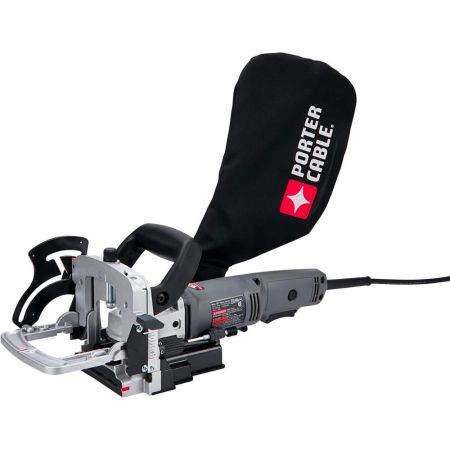We may earn revenue from the products available on this page and participate in affiliate programs. Learn More ›
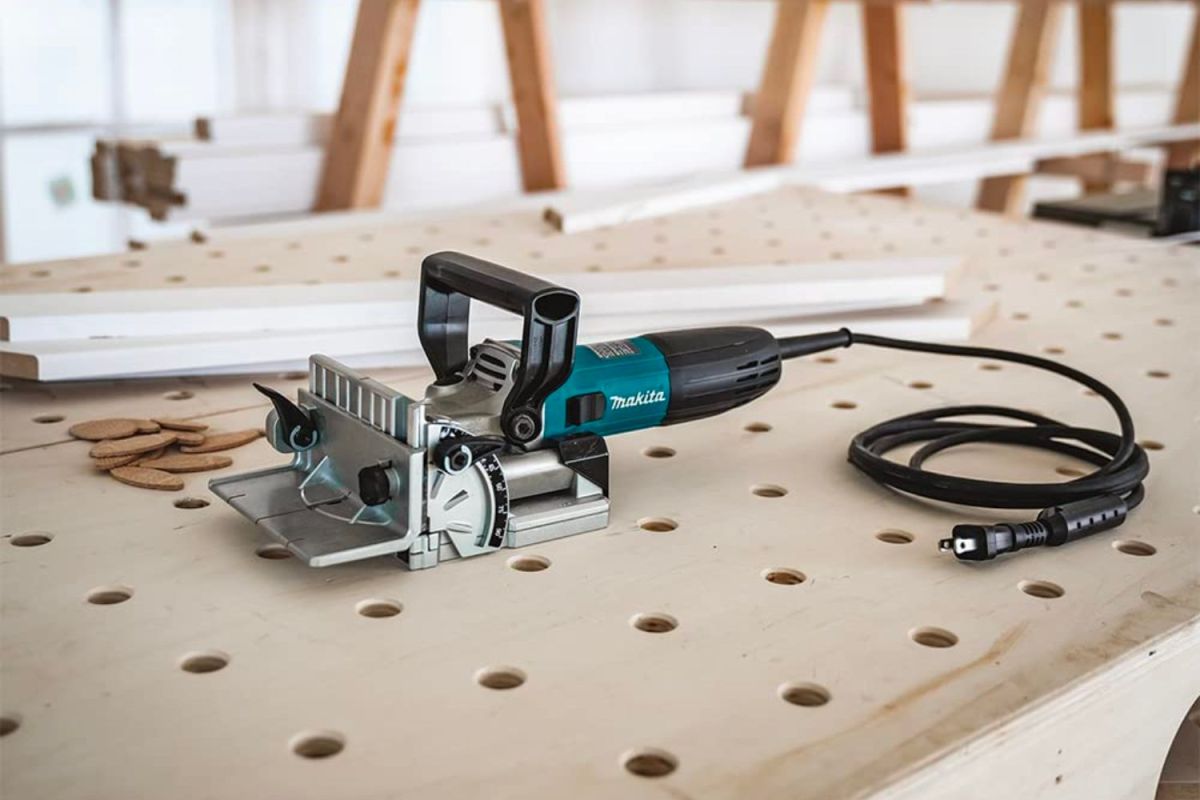
As a woodworker or DIYer, there are certain essential tools that, once the DIYer discovers them, help unlock their real potential. Among those tools is the trusty biscuit joiner. This power tool helps make creating strong joints and large, flat surfaces easier—and produces better results.
Whether it’s for gluing up a new worktop for a shop bench or building a bookshelf from scratch, the best biscuit joiner can help. These handy tools use small, circular saw blades to cut slices in two pieces of wood, allowing woodworkers to insert a biscuit (a small, football-shaped chunk of compressed wood) in the two slots to create a solid joint. The glue-covered biscuit then expands, locking the two boards together and creating an incredibly strong joint that glue alone can’t match.
Use this guide to learn the factors and features to consider when shopping for the best biscuit joiner and why the following tools are considered to be among the best models available.
- BEST OVERALL: Makita PJ7000 Plate Joiner
- RUNNER-UP: DeWalt DW682K Plate Joiner Kit
- BEST BANG FOR THE BUCK: Wen JN8504 8.5-Amp Plate and Biscuit Joiner
- BEST FOR BEGINNERS: Ryobi JM83K 6-Amp AC Biscuit Joiner Kit
- BEST CORDLESS: Makita XJP03Z 18V Lithium-Ion Cordless Plate Joiner
- BEST FOR WOODWORKING: Festool 574432 Domino Joiner DF 500 Q-Set
- BEST FOR CABINETMAKING: Porter-Cable 557 7-Amp Deluxe Plate Joiner Kit
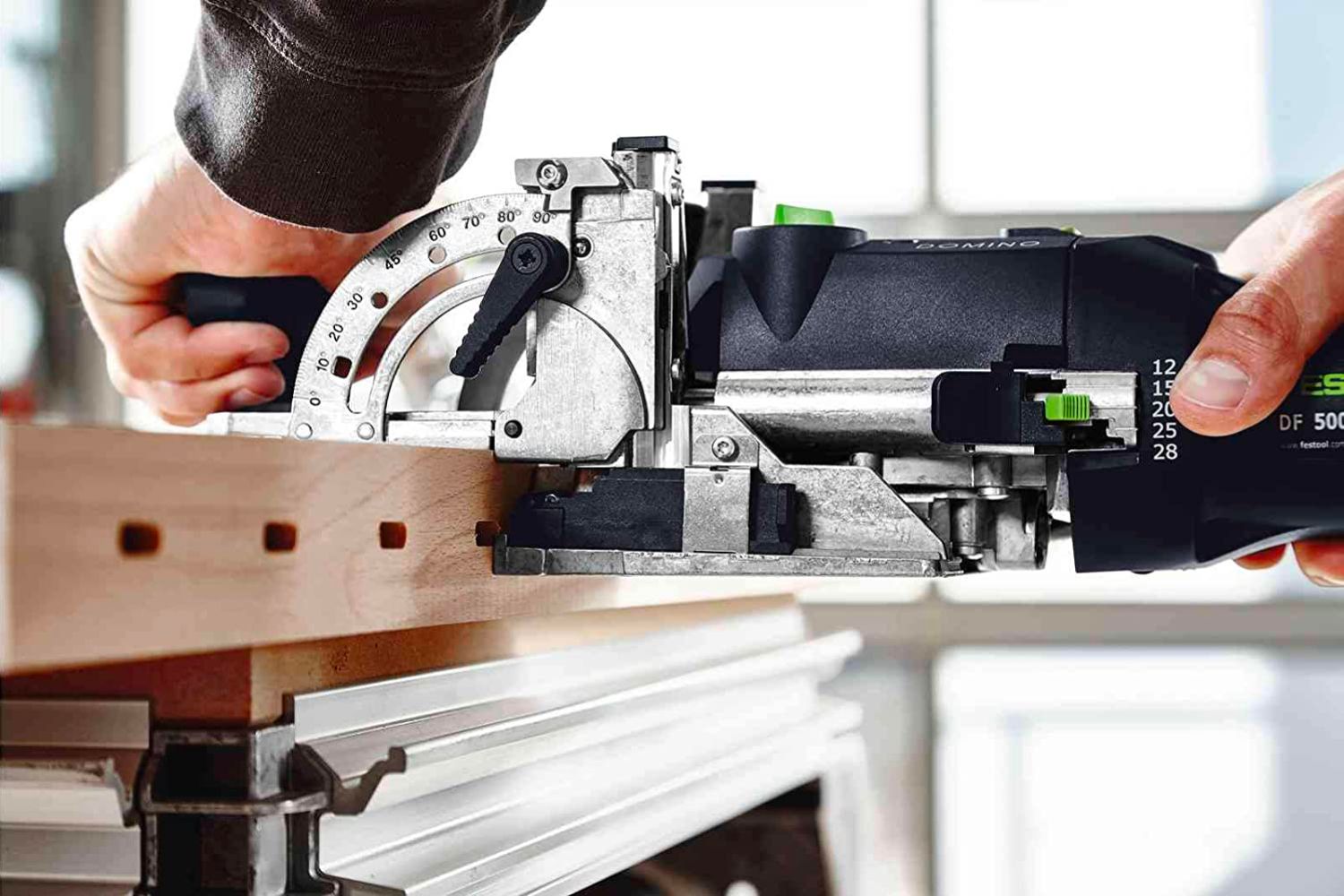
How We Chose the Best Biscuit Joiners
For woodworking or at-home projects, biscuit joiners offer precise and strong joints, cuts, and flat surfaces with minimal effort. Selecting the best biscuit joiners on the market depends on power output, adjustability, added attachments and accessories, and ease of use.
Our top picks come with powerful motors of 5.6 to 8.5 amps for speeds between 10,000 and 12,000 revolutions per minute (rpm). This power output is aided by adjustable angles and depths for quick and clean cutting. Many of these picks have 0- to 90-degree angles, with a select few topping out at 135 degrees. Plus, some of these top picks come with multiple preset depths.
Though the biscuit-cutter tools themselves are the most important feature, these joiners also come with dust bags, blade replacements, carrying cases, and more for convenience and safe storage. Plus, those with barrel grips and positive stops allow for maximum control while operating.
Our Top Picks
The following list includes some of the best biscuit joiners available for woodworking projects. Whether for a beginner, a pro woodworker, or someone with a skill set that lands in between, shoppers are likely to find a quality tool for their workshops here.
Best Overall
Makita PJ7000 Plate Joiner
See ItFolks looking for an all-around biscuit-joiner tool that really holds its own will want to check out the Makita plate joiner. This barrel-handled biscuit joiner has a 5.6-amp motor, and while that is on the lower end compared to some competitors, it produces speeds up to 11,000 rpm for dense hardwoods. It weighs just 5.5 pounds, has a maximum cutting depth of ¾ inch, and includes a carrying case as well as a 4-inch carbide-tipped blade.
The PJ7000 offers lots of adjustability. The fence has a rack-and-pinion vertical adjustment that allows users to dial the joiner into the perfect height. The fence also adjusts between 0 and 90 degrees, with positive stops at 0, 45, and 90. The PJ7000 has six different depth adjustments, with one-touch stops for standard biscuit sizes of #0, #10, and #20.
Product Specs
- Power source: Corded
- Biscuit size: #0, #10, and #20
- Handle type: Barrel
Pros
- Enough power to produce speeds up to 11,000 rpm with a weight of just 5.5 pounds
- Barrel-shaped handle allows for plenty of accuracy, ensuring biscuits align
- 6 depth adjustments let users dial in the ideal depth for their biscuits and the amount of glue they need
Cons
- 5.6-amp motor is on the less powerful side, meaning this isn’t the heaviest-duty model
Get the Makita PJ7000 biscuit joiner at Amazon, The Home Depot, or Acme Tools.
Runner-Up
DeWalt DW682K Plate Joiner Kit
See ItThe DeWalt DW628K plate joiner kit might be just the ticket for DIYers looking for a high-quality biscuit joiner with a heavy-duty motor. This barrel-handled joiner features a 6.5-amp motor that runs up to 10,000 rpm, capable of cutting through dense hardwood.
The DW682K has plenty of high-end features. The fence has dual-sided vertical rack-and-pinion adjustments, which keep the blade and fence as parallel as possible. The fence is adjustable between 0 and 90 degrees, with a positive stop at 45 degrees. It also has adjustments for #0, #10, and #20 biscuits.
The DeWalt comes with a carbide blade, Torx key (for the blade), wrench, dust bag, and soft bag for storage. It also includes a vacuum attachment, allowing users to hook up a shop vac or dust-collection system to the dust port for simple cleanup. It does weigh 6.6 pounds, so it might be a bit on the heavier end for all-day use.
Product Specs
- Power source: Corded
- Biscuit size: #0, #10, and #20
- Handle type: Barrel
Pros
- Heavy-duty 6.5-amp motor should bore through dense hardwoods without issue
- Fence angle adjusts between 0 and 90 degrees, with a positive stop at 45 degrees for miters
- Dual rack-and-pinion fence allows for accurate height adjustments and keeps the place parallel to the blade
Cons
- It may be a bit on the heavier end for all-day use
Get the DeWalt biscuit joiner at Amazon, Ace Hardware, Lowe’s, The Home Depot, or Acme Tools.
Best Bang For The Buck
Wen JN8504 8.5-Amp Plate and Biscuit Joiner
See ItDIYers looking to spend as little as possible on a new biscuit joiner might want to consider the Wen JN8504. It has an incredibly meager price tag but still boasts a powerful 8.5-amp motor with a cutting speed of up to 10,000 rpm. It comes with several biscuits, a wrench for blade changes, and a plastic carrying case.
This model features an adjustable fence as well as an angle gauge that adjusts between 0 and 90 degrees (though there aren’t any positive stops). It has an inline handle and dust extraction as well as adjustable depths that accommodate #0, #10, and #20 biscuits. Keep in mind that this is a very budget-friendly tool, so it may not have the bells and whistles or fine adjustments of more expensive models.
Product Specs
- Power source: Corded
- Biscuit size: #0, #10, and #20
- Handle type: Barrel
Pros
- Low price point makes it accessible to almost any budding woodworker
- Features a heavy-duty 8.5-amp motor that produces 10,000 rpm for dense woods
- Also has standard features like fence angle adjustments and dust extraction
Cons
- It doesn’t have the fine adjustments, stops, or bells and whistles of premium models
Get the Wen biscuit joiner at Amazon, Lowe’s, or The Home Depot.
Best For Beginners
Ryobi JM83K 6-Amp AC Biscuit Joiner Kit
See ItFor those on the hunt for a versatile biscuit joiner for workshop projects that’s beginner-friendly in terms of both price and usability, the Ryobi JM83K biscuit joiner is worth checking out. This kit has a tough 6-amp motor that produces speeds up to 11,000 rpm for boring through hardwoods. It comes with an assortment of biscuits, a dust bag, and a carrying case—everything to start new users off on the right foot.
The Ryobi’s angle range makes it a unique tool. While most competitors offer only 0- to 90-degree angles, the Ryobi can go up to 135 degrees for improved functionality. Within its wide range, it has positive stops at 0, 45, 90, and 135 degrees. It has depth adjustments for #0-, #10-, and #20-size wood joining biscuits, as well as rack-and-pinion vertical adjustment and a D-shaped handle. While the handle may cost it a few points in terms of accuracy, it’s comfortable for beginning biscuit cutters.
Product Specs
- Power source: Corded
- Biscuit size: #0, #10, and #20
- Handle type: D-shaped
Pros
- D-shaped handle is comfortable for newer users, allowing them to get accustomed to biscuit cutting
- Adjustable fences with a range between 0 and 135 degrees, allowing for more versatility than most other biscuit joiners
- Comes with biscuits, a dust bag, and a carrying case to start users off on the right foot
Cons
- The D-shaped handle might lose a few points in the accuracy department
Get the Ryobi biscuit joiner at The Home Depot or Amazon.
Best Cordless
Makita XJP03Z 18V Lithium-Ion Cordless Plate Joiner
See ItFinding a high-quality cordless biscuit joiner can be tough, but most DIYers will find that the Makita XJP03Z 18V lithium-ion cordless plate joiner fits the bill. This biscuit joiner uses Makita’s 18V LXT lithium-ion battery system to produce a top speed of 12,000 rpm. It can produce up to 320 cuts (or 160 joints) on one battery, allowing for long-term biscuit cutting without a cord holding the tool back.
The XJP03Z has plenty of adjustment features as well. It has six depths with positive stops for #0, #10, and #20 biscuits. It also has rack-and-pinion vertical adjustment (though only one side) of the cast-aluminum fence and a range between 0 and 90 degrees, with a positive stop at 45 degrees. It’s available for purchase as a set with a battery or as a stand-alone tool for those who already own a battery for other Makita tools.
Product Specs
- Power source: 18V battery
- Biscuit size: #0, #10, and #20
- Handle type: Barrel
Pros
- Despite being a battery-operated biscuit joiner, it produces motor speeds up to 12,000 rpm
- Cuts up to 160 joints on a fully charged battery
- Cordless portability means users can take it wherever they need it without a cord holding them back
Cons
- It only has rack-and-pinion height adjustment on one side, despite being a premium tool
Get the Makita biscuit joiner (tool only) at Amazon, The Home Depot, or Acme Tools.
Best For Woodworking
Festool 574432 Domino Joiner DF 500 Q-Set
See ItThe Festool 574432 Domino joiner might not be exactly a biscuit joiner, but it’s one of the best tools for similar joinery in furniture and woodworking. The Domino uses Festool-specific hardwood tenons (candy-bar-shaped inserts that take the place of traditional biscuits). Instead of a circular blade, it has a drill bit-like spiral cutter to bore the mortises. This allows users to adjust the depth to prevent it from poking through a workpiece while still getting plenty of surface area for glue.
Despite the unconventional joinery method, the Domino does have the flexibility of other biscuit joiners, with a few extras. Users can adjust the fence angle between 0 and 90 degrees, with stops at 22.5, 45, 67.5, and 90 degrees—two more stops than its competitors. It has multiple height adjustments and depth settings for fast, easy, and accurate adjustments. Festool is also known for employing effective dust extraction.
This kit comes with a carrying case and several guides and fences. Shoppers should know, however, that the floating tenons (Festool calls them Dominoes) may not be as readily available as biscuits.
Product Specs
- Power source: Corded
- Biscuit size: Uses Dominos with 5, 6, 8, and 10 millimeter diameters
- Handle type: Barrel
Pros
- Domino mortises provide more surface areas for glue than biscuits, allowing for stronger joints
- Several depth adjustments allow users to bore deep, flat-bottomed mortises that hold well without poking through the workpiece
- It has multiple angle stops, allowing users to customize their woodworking designs
Cons
- It’s not exactly a biscuit joiner, and Festool Dominoes aren’t available everywhere
Get the Festool biscuit joiner at Amazon or Acme Tools.
Best for Cabinetmaking
Porter-Cable 557 7-Amp Deluxe Plate Joiner Kit
See ItCabinetmaking requires a lot of joinery, and dense hardwood plywood can be tough on a biscuit woodworking joiner. For those situations, consider the Porter-Cable plate joiner kit. It features a wide fence angle range, multiposition depth stop, and a 7-amp motor that runs at 10,000 rpm, boring through dense plywood over and over again.
This barrel-handled model is heavy duty but also has some desirable features for cabinetmaking. The fence tilts from 0 to 135 degrees, with a positive stop at 90 degrees, allowing users to create catty-corner cabinets and face frames without setting up complicated jigs or strange angles. It also has seven depth stops, handling #0, #10, and #20 biscuits. Just note that its heavy-duty size does come with some heft, so it may be a bit large for some users.
Product Specs
- Power source: Corded
- Biscuit size: #0, #10, and #20
- Handle type: Barrel
Pros
- Heavy-duty 7-amp motor allows it to bore through dense plywood and hardwood all day
- Fence adjusts between 0 to 135 degrees, with multiple positive stops for complicated miters
- Many attachments and accessories included
Cons
- It might be a bit large for some users or lead to fatigue during long sessions
Get the Porter-Cable biscuit joiner at Amazon, Lowe’s, Acme Tools, or Rockler.
Jump to Our Top Picks
What to Consider When Choosing a Biscuit Joiner
Once a DIYer gets their hands on a biscuit joiner, they might wonder how they ever finished woodworking projects without one. They’ll no doubt come to rely on it a lot, so choosing a quality model is key. Here’s what to keep in mind when shopping for the best biscuit joiner.
Size and Weight
Usually, the larger and heavier the wood biscuit cutter, the better the quality of its parts, and a bruiser of a biscuit joiner will likely have a heavy-duty motor and high-quality slides (which guide the blade while it cuts to provide consistent results). However, a heavy biscuit joiner or a super high-end tool isn’t necessary or even ideal for everyone. There are plenty of midrange options weighing around 5 or 6 pounds—about half the weight of a high-end model—that will do the trick.
Determining whether a burly biscuit joiner is necessary will come down to the types of projects and how often the joiner will see use. For the overwhelming majority of DIYers, a midrange biscuit joiner will handle materials like oak and maple without issue. For those working in a cabinet shop and putting a joiner through its paces daily, consider the heavier-duty options.
Corded vs. Cordless
As with all power tools, the debate of corded versus cordless exists in the biscuit-joinery world. Deciding on a style often just comes down to personal preference.
Almost all biscuit joiners are corded. Since most woodworking projects take place in a workshop, there’s usually power readily available. Also, it’s not typical to be climbing a ladder or working under a cabinet with a biscuit joiner, so portability isn’t really an issue.
Biscuit joinery puts quite the tax on a battery, so most manufacturers haven’t taken the dive into cordless joinery. However, there are a few cordless biscuit joiners available. These can be quite handy during projects like kitchen remodels, where the user might need to join two sections of wooden countertops and would prefer not to set up an extension cord.
Power and Speed
Biscuit joiners need to be stout power tools with tough parts and plenty of power and speed. While it might not take much power to bore a hole in pine or cedar, plunge cutting a section of hickory or walnut can be a challenge.
The most important power-related factor to consider when shopping is a biscuit joiner’s amperage rating. Amperage refers to the current load a motor can handle before its parts start to fail. This has much to do with the quality of individual components inside the tool and how well it can cool itself while running. Ideally, look for a model with 5 to 7 amps.
When it comes to actually getting the work done, speed matters as well. The faster the motor, the faster it can spin the blade and cut a biscuit slot. Look for models with rpm ratings between 8,000 and 10,000 for good general use.
Biscuit Size
Biscuit joiners use biscuits to join workpieces together. When the user inserts a glue-covered biscuit into a slot, it locks in to join two workpieces as one. Biscuits come in small, medium, and large sizes (#0, #10, and #20, respectively). To accommodate different-size biscuits, most joiners have settings that adjust for deeper or shallower cuts, some cutting as deep as ¾ inch; other models may require a blade change.
While biscuit size might not be a factor when shopping for a biscuit joiner, it can be important while working. For example, bookshelves and countertops might require a lot of gluing surface—and a bigger biscuit—while only a smaller biscuit might fit in a cabinet face frame.
Blades
Although biscuit joiners use circular-shaped saw blades, they’re quite a bit different than the blades found in a miter, table, or circular saw. They’re thicker, with much fewer teeth, and they’re much smaller in diameter.
Burrowing a spinning blade into dense hardwoods over and over again builds up quite a bit of heat and pressure, so blade material and longevity matter. Most biscuit joiner manufacturers use carbide-tipped blades, as they stay sharper longer than a lower-end steel blade, particularly for denser materials like walnut and hickory. They also hold up better to the speeds of high-end biscuit joiners.
Cutting Angle and Depth
One feature most woodworkers appreciate about biscuit joiners is the tools’ versatility. The adjustable cutting angles provide the ability to cut slots in a wide range of situations. While edge joining two boards is the most obvious use for biscuit joiners, they can also bore biscuit slots for mitered corners and angled joinery or slots in the field of a workpiece for shelves or other uses. This is thanks to their adjustable fences, which users can set for a particular angle to bore an accurate slot.
Adjustable cutting depth is also an important feature. Swapping between preset depths allows users to use different biscuit sizes quickly without worrying if the joint will be tight or hold enough glue.
Handle Type
When choosing the best biscuit joiner for a workshop, consider handle preference. There are two main styles: barrel handles and D-shaped handles.
Barrel-style handles can facilitate precise boring, so they’re better for control. With these models, the hand is in line with the slot being cut, making it easier to stay steady and bore an accurate slot. There are also many models with top-mounted handles to steady the tool even more.
D-shaped handles are less accurate but more comfortable. The hand’s upright orientation is more natural and easier to push. However, the hand will be higher than the blade, so it’s possible to wobble and make a sloppy cut.
Additional Features
Biscuit joiners may include some additional features that can make storage simpler and cleanup easier.
A sturdy box will keep a biscuit joiner secure when it’s not in use. Many manufacturers package their tools in hard plastic containers that can store a joiner, a few biscuits, and other small items. These cases also make it a cinch to stack tools on a shelf or under a workbench.
As the user bores slots with a biscuit joiner, they can make quite a mess with sawdust and wood chips. The best biscuit joiners come with bags that attach to the exhaust port, catching most of these particles before they hit the ground or air.
Safety Tips for Using a Biscuit Joiner
In general, biscuit joiners are safe power tools—but that could inspire some false confidence. As users become more comfortable using theirs, they might feel they can hold the workpiece with one hand while operating the tool with the other. It’s best to avoid this temptation, as the front lip of the board could lift, potentially causing the blade to strike a hand. Instead, clamp the workpieces to a workbench for a stable base.
Before cutting slots for biscuits, ensure that there are no nails, knots, or other obstructions where the joiner will be cutting. In most cases, the blade will simply cut through these obstructions, dulling the blade a bit. However, there is potential for the biscuit joiner to send a chunk of the obstruction flying with enough speed to cause injury.
Biscuit joiners can produce a lot of dust. While a dust-collection system helps reduce the amount of sawdust, it can’t get it all. Be sure to wear a mask to avoid breathing in airborne dust and safety glasses to keep eyes protected. This safety gear is especially important when working with plywood and medium-density fiberboard (MDF). The glues and chemicals used in their manufacturing can be particularly irritating to lungs and eyes.
- Clamp the workpiece to a bench to avoid potentially striking a hand with the biscuit joiner.
- Ensure the workpiece is free of obstructions like nails and knots before cutting biscuit slots.
- Wear safety glasses and a mask for protection from sawdust.
FAQs
While you may be excited about getting started with a new biscuit joiner, if you still want more info, refer to the answers to these frequently asked questions regarding biscuit joiners and how they work. If you don’t see the required answer here, reach out to the manufacturer’s customer service department and speak with a representative.
Q. What is the difference between a plane, a jointer, and a biscuit joiner?
There are planes, jointers, and biscuit joiners, and they each work differently. A plane is a handheld tool that comes in different sizes and is used for flattening high spots or removing material from a board’s surface. A jointer is typically a floor-mounted power tool (though there are benchtop models as well) that’s used to create a perfectly flat and square board. A biscuit joiner creates slots for biscuits within a joint, producing extra glue surface and perfect orientation for joinery.
Q. What speed should I look for in a biscuit joiner?
To ensure that your biscuit joiner can handle hardwoods, look for one with a 9,000 rpm or higher top speed.
Q. How deep does a biscuit joiner cut?
Most biscuit joiners can cut as deeply as ¾ inch, providing more than enough room for a #20 biscuit.
Q. How many biscuits should I use to join wood?
A good rule of thumb is to use a biscuit every 6 to 12 inches. For weight-bearing projects like shelves and countertops, 6 inches is best to provide support.
Q. What materials can a biscuit joiner work with?
You can use biscuits with a range of wood-based products: hardwoods, softwoods, plywood, MDF, and even laminated particleboard can work with a biscuit joiner.
Why Trust Bob Vila
Bob Vila has been America’s Handyman since 1979. As the host of beloved and groundbreaking TV series including “This Old House” and “Bob Vila’s Home Again,” he popularized and became synonymous with “do-it-yourself” home improvement.
Over the course of his decades-long career, Bob Vila has helped millions of people build, renovate, repair, and live better each day—a tradition that continues today with expert yet accessible home advice. The Bob Vila team distills need-to-know information into project tutorials, maintenance guides, tool 101s, and more. These home and garden experts then thoroughly research, vet, and recommend products that support homeowners, renters, DIYers, and professionals in their to-do lists.
